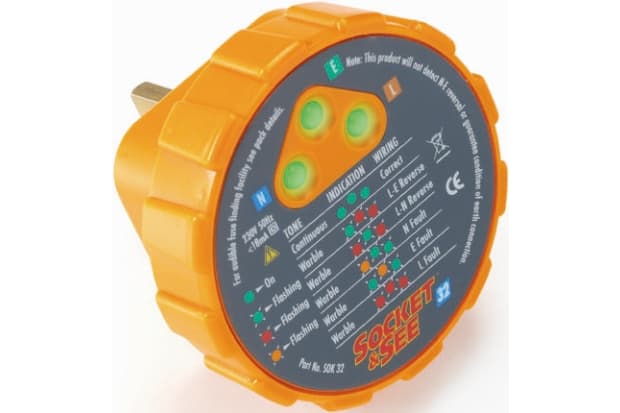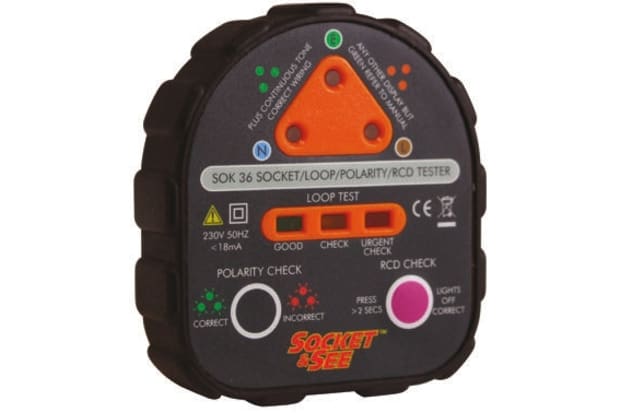- เผยแพร่เมื่อ 20 มี.ค. 2567
- แก้ไขครั้งล่าสุด 20 มี.ค. 2567
- 6 นาที
A Complete Guide to Socket Testers

What is a Socket Tester?
A socket tester is a handheld electrical device used to quickly assess whether wall sockets are properly wired and working safely. They are plugged directly into a mains socket or via an attached plug connected by a lead.
Once inserted, most models use LEDs - normally three in number - on the back of the device as their signalling mechanism.
These will be illuminated, usually in combination with tones or alert sounds, in various combinations in response to the level of alternating current (AC) and voltage - or lack of those - coming through the socket from the mains. Socket testers are designed to detect the presence of some common wiring issues, such as neutral and earth wiring faults.
A neutral wire connects an electrical circuit back to its source, while an earth wire runs from an electrical device into the ground to discharge excess current and minimise the risk of electrocution or circuit damage. The latter is also called a ground or ground wire.
The neutral and ground wires can be tested simultaneously. Different models of socket tester offer additional features - for example, fuse and fault location or electrical polarity testing. Polarity (the arrangement of the positive and negative poles in an electrical circuit) plays an important role in an alternating current because it is switched back and forth many times a second. Tracking and identifying polarity is important to ensuring that circuits and the equipment in which they are located work correctly.
Socket testers are a standard inclusion in electrician's toolboxes, along with the toolkits of installation and maintenance engineers.
Socket testers have several alternative names, including:
- Socket checkers
- Mains polarity tester plugs
- Mains socket testers
- Mains testers
- Plug-in mains testers
- Plug-in socket testers
- Receptacle testers
- Electrical outlet testers
You may also see them referred to as PAT testers. However, portable appliance testing is a broad category of electrical appliance testing defined by the Health and Safety Executive.
How Do Socket Testers Work?

So, how do mains socket testers work? These electrical devices contain a microprocessor connected to a conductor circuit. Once the plug socket tester has been inserted, the processor will analyse the flow of current - the continuity - along with the polarity of the connections with which it comes into contact.
Testers check whether each contact in the socket is connected to the correct wire. They will then display any wiring fault types detected via a pre-programmed sequence of LEDs and tones.
Basic socket testers are designed to be simple, first-line-of-defence devices, but they cannot detect several potentially serious wiring faults. Some examples of this are earth neutral reverse, where the earth and neutral wires have been mistakenly swapped, or the overall electrical resistance or impedance in a circuit. These require more advanced models or the use of different testing equipment, such as a multimeter.
Socket Tester Types
A variety of designs is available. Most models use LEDs, but some have front panel displays. Three-pin plug socket testers are the default but four and five-pin models are also available. Most include audible alarms - however, simpler, sound-free models can be found.
Beyond these varying features, socket testers fall into three broad categories:
Simple Socket Testers
Regular socket testers can detect a range of wiring fault conditions in power outlet sockets. They are normally the same size as a standard 13-amp plug.
Advanced Socket Testers
These offer more advanced testing functions, including earth fault loop impedance readings i.e. the amount of resistance encountered by faulty current flowing to the earth wire and terminal.
Professional Socket Testers
These include professional-grade tests, such as advanced earth loop impedance readings.
Amperage
The ampere, more commonly known as an amp, is the internationally recognised unit of electrical current. A larger amperage indicates a greater quantity of electrical charge. Polarity tester plugs are available with different current ratings, meaning the amperage they are designed to operate safely within. These include standard 13a and 16-amp ratings, as well as:
- 11 amps
- 32 amps
- 63 amps
Voltage
While amps measure the volume of electrons, voltage indicates the strength or pressure of a current. Different models of plug checkers are designed to work within different voltage ranges. These include:
How to Use a Socket Tester?

Socket testers are small, straightforward devices that will easily fit into a pocket. They do not require significant training to use but familiarity with electrical wiring principles is beneficial.
Here's how to test sockets for power and wiring faults:
- Switch off the socket
- Remove any other plugs or devices from the mains socket
- Insert your socket tester
- Switch the power back on and await the results
If all three LEDs illuminate, no faults have been detected. Models from different manufacturers will display faults by lighting the LEDs in particular sequences or colours, sometimes alongside an alert sound. Basic electric plug testers detect a limited range of commonly encountered electrical faults.
These include:
Live Neutral Reverse
Live neutral reverse is a term used by electricians to indicate that the neutral wire in a socket has been wrongly connected to the terminal intended for the live or hot wire. This is a safety hazard because it means that the socket cannot properly be turned off. Even when it is supposedly switched off, it will remain live, with electricity continuing to flow.
Live Earth Reverse
This term means that the live and earth wires in a socket have each been connected to the terminals intended for the other. This is dangerous because it means that exposed parts of the apparatus will be live and users could receive a potentially fatal electric shock.
No Earth or Missing Earth
The earth wire, used to safely discharge excess current, is not wired to the intended terminal.
Neutral Fault or Missing Neutral
The neutral wire is the conductor which completes a circuit, returning to the start point. Most socket testers will indicate if this is not connected, connected incorrectly, not in contact with the ground, or some other fault is present.
Live Fault
This reading indicates a fault in the live or hot wire. It may be damaged or wired incorrectly, for example. The live wire is sometimes indicated by the letter P (power).
You will find a key to the readings displayed on the back of the device. Some models will also indicate the specific location of a fault on the live, neutral or earth wires.
Testing the power and wiring of electrical outlets is an essential safety practice and one that should be undertaken regularly to catch any developing faults.
With the right equipment, socket testing is a speedy and simple process and one that does not require technical knowledge. However, electrical maintenance is a specialist job and one that should only be undertaken by properly qualified electricians or technicians.
What is the Best Socket Tester for You?
The best socket tester for you will depend on the electrical sockets you routinely need to check and the kinds of tests you need to conduct. Assess your socket tester requirements. Are you an electrician in need of all available metrics? An engineer monitoring electrical equipment? Or someone simply concerned with ensuring the safety of particular sockets?
Discuss your needs with our expert team. We can advise you on the best products currently available for all your plug and socket testing requirements.
Popular Socket Tester Brands
Quality socket testers are produced by several leading electrical equipment manufacturers. These include: